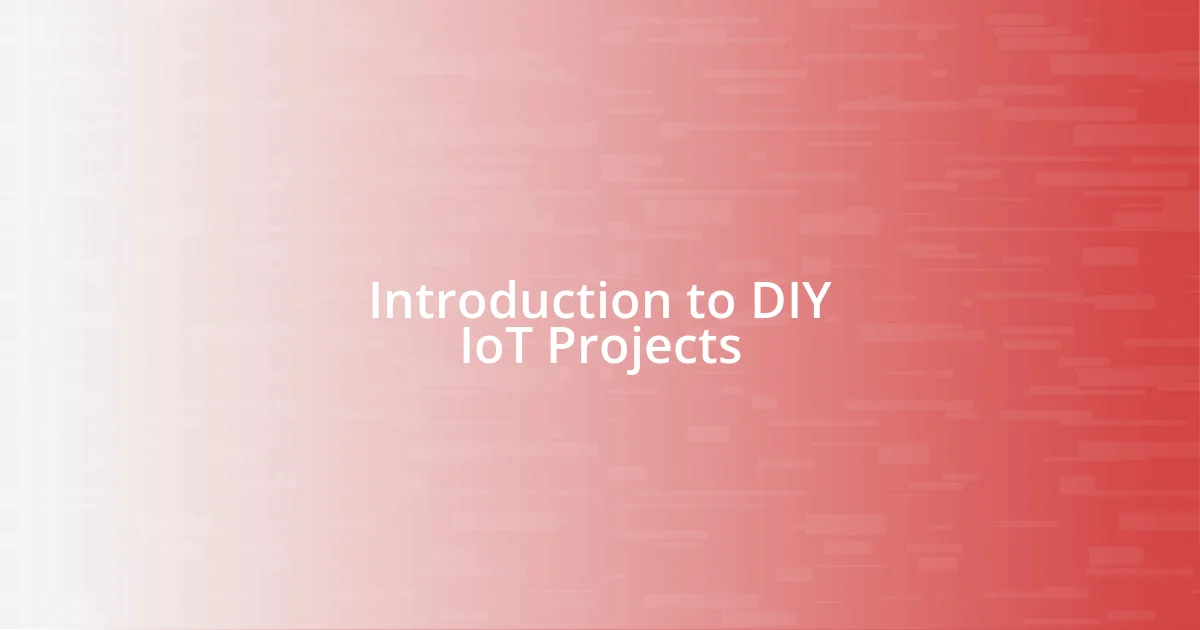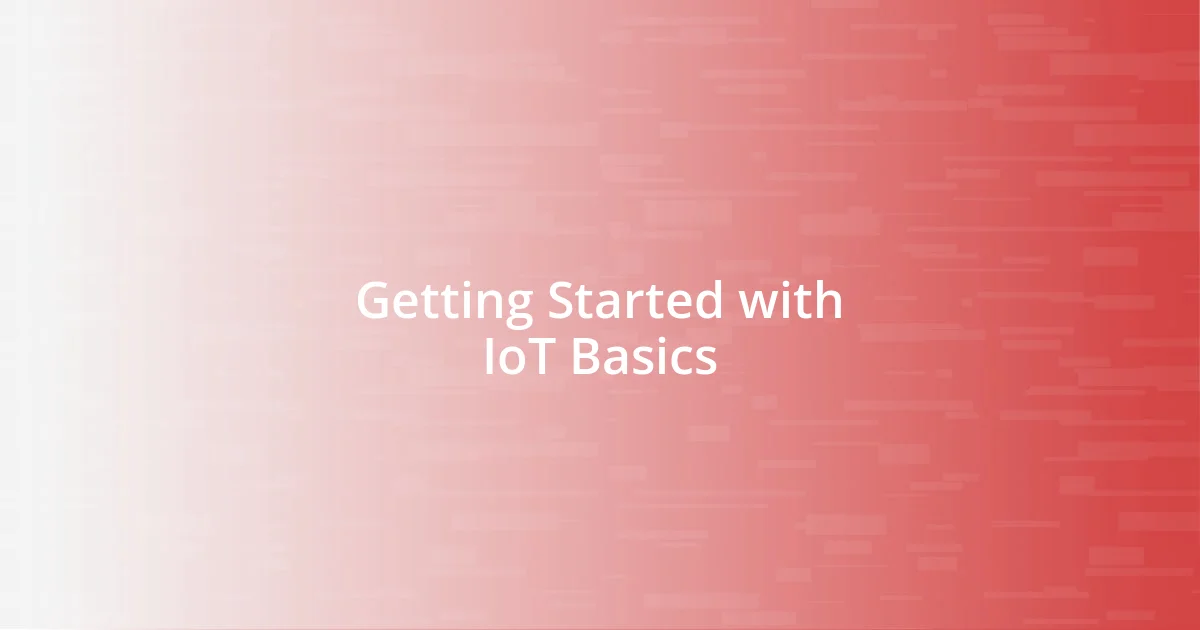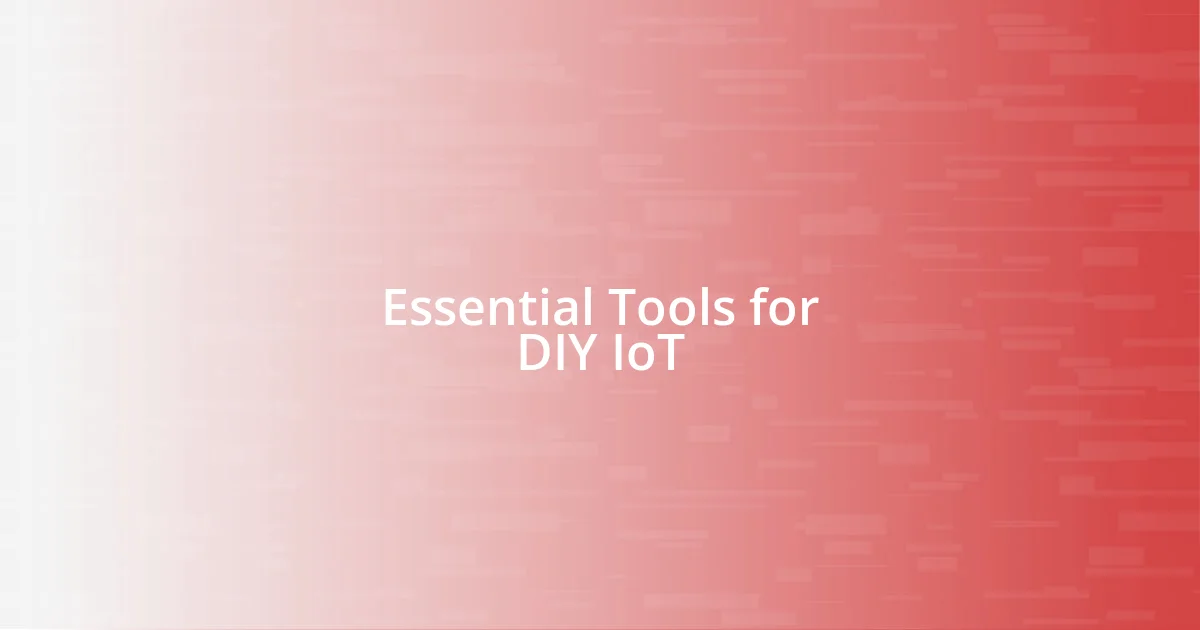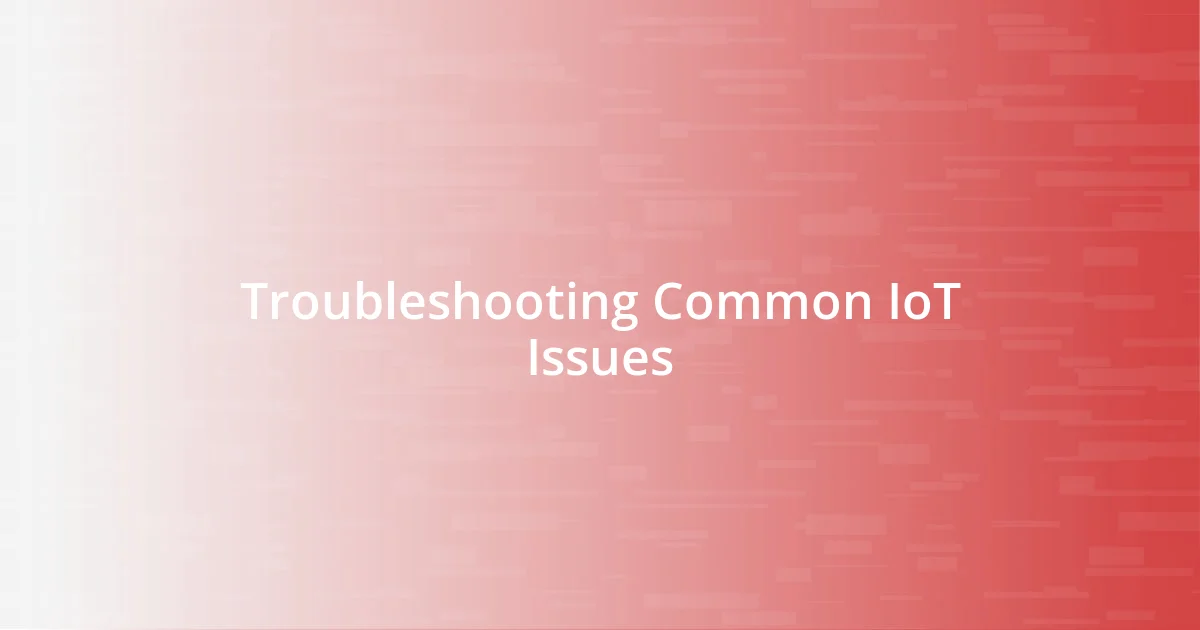Key takeaways:
- Starting with simple DIY IoT projects fosters skill development and confidence, unlocking new possibilities for creativity.
- Essential tools like microcontrollers, sensors, and development environments form the backbone of successful IoT projects.
- Sharing experiences in the DIY community enhances learning, inspires others, and fosters valuable constructive feedback.

Introduction to DIY IoT Projects
Diving into DIY IoT projects can feel like opening a doorway to endless possibilities. I remember the first time I connected my home lights to my smartphone—it was a small win, but the thrill of controlling my environment from the palm of my hand was exhilarating. Have you ever thought about how empowering it feels to create something that enhances your daily life?
There’s an undeniable satisfaction that comes with building your own smart devices. When I managed to monitor my garden’s soil moisture using a simple sensor and a microcontroller, I felt a surge of pride. It’s not just about the technology; it’s about nurturing a project from scratch and watching it bloom, much like the plants I was helping.
Understanding the basics of IoT—like how devices communicate and collect data—can seem daunting at first. However, I found that starting with simple projects helps break down those barriers. Each small step I took seemed to unlock new skills and insights, prompting me to wonder: what can I create next? This journey truly is about exploration and growth, leading to a greater appreciation of the interconnected world around us.

Getting Started with IoT Basics
Getting started with the basics of IoT requires understanding a few key concepts. I remember when I first stumbled upon the idea of devices communicating over the internet; it was like a light bulb moment. I quickly learned that, at its core, IoT involves connecting devices to gather and exchange data, which opens up endless possibilities for automation and enhancement.
Here’s a quick overview of essential IoT concepts to kickstart your journey:
- Devices and Sensors: The backbone of IoT; these collect the data.
- Connectivity: How devices communicate, typically over Wi-Fi, Bluetooth, or cellular networks.
- Data Processing: The analysis part, where gathered data becomes meaningful insights.
- User Interfaces: The front end, which allows us to interact with our devices, often via apps or web dashboards.
With this foundational knowledge, you’ll feel more prepared to embark on your own IoT projects. Each new concept I learned felt like unlocking a new feature in a game I loved—adding complexity yet making the experience all the more rewarding. There’s something so fulfilling about watching it all come together, knowing that you have the power to create your smart ecosystem.

Essential Tools for DIY IoT
When gearing up for DIY IoT projects, having the right tools in hand makes a world of difference. From my own experience, starting with a good microcontroller—like the Arduino or Raspberry Pi—was pivotal. These platforms will not only support your projects but also grow with you as your skills improve. I still remember the excitement of programming my first Arduino—seeing it respond to my code felt like magic!
Additionally, don’t overlook the importance of sensors and connectivity modules. Initially, I was overwhelmed by the range of options available, but I quickly learned that choosing the right sensors, such as temperature or humidity sensors, can significantly impact your project’s success. The first time I integrated a Bluetooth module into a project, I was on cloud nine, realizing I could communicate wirelessly with my device. It’s those moments that really fuel your creativity.
Lastly, building a solid software environment is crucial. I recommend using development tools like the Arduino IDE or Python, which are both user-friendly and powerful. I found that spending time getting comfortable with these platforms pays off exponentially when troubleshooting or expanding your projects later on. It’s all about creating a reliable foundation that enhances your journey into the IoT world.
| Tool | Description |
|---|---|
| Microcontroller (e.g., Arduino, Raspberry Pi) | Versatile platforms for building and programming devices with ease. |
| Sensors (e.g., temperature, humidity) | Essential for gathering data from the environment, enabling real-time monitoring. |
| Connectivity Modules (e.g., Wi-Fi, Bluetooth) | Facilitate communication between devices and the internet or other devices. |
| Development Tools (e.g., Arduino IDE, Python) | Software environments for coding, debugging, and deploying projects effectively. |

Troubleshooting Common IoT Issues
One of the most common issues I encountered with my IoT projects was connectivity problems. I remember spending hours troubleshooting why my device wouldn’t connect to the Wi-Fi network. It turns out that a simple typo in the SSID or password could shut everything down. Have you ever felt that rush of frustration when you realize the issue is something so minor? Checking your network settings should always be the first step—it’s amazing how often that resolves the problem.
Another challenge that often popped up was sensor calibration. I vividly recall my first experience with a temperature sensor reading consistently 5 degrees off. It was disheartening at first. But once I learned to calibrate the sensor correctly, it felt like I had just solved a mystery puzzle. Ensuring that your sensors are calibrated and functioning as intended is crucial for accurate data. So, how do you spot calibration issues? Trust your instincts; if the data seems off, it probably is.
Lastly, I’ve faced issues with software bugs that seemed to appear out of nowhere. I once spent an entire evening trying to understand why my code was producing odd behavior, only to realize I had neglected proper exception handling. Have you had that moment when you feel like you’re talking to your computer, pleading it to cooperate? Adding checks for potential errors not only helps in troubleshooting but also enhances the reliability of your IoT projects. It’s those little things that can make a big difference in your journey.

Sharing Your IoT Experience
Sharing your IoT experience can be both enlightening and rewarding. I remember my first blog post, where I detailed how I built a smart plant watering system. The joy of sharing my journey sparked more conversations than I expected! It was amazing to connect with others, share tips, and even troubleshoot challenges together. Have you shared your projects? You might be surprised by the support and inspiration you can find within the DIY community.
When I started documenting my projects on social media, I found that feedback from others was invaluable. There was a moment when a fellow enthusiast suggested a modification to my code that made my air quality monitor way more efficient. I couldn’t believe how a single suggestion from someone else completely transformed my project. This interaction not only helped my project but also deepened my understanding of IoT concepts. It just goes to show how sharing can lead to community growth—what tips or lessons could you share that might help someone else?
I’ve also had the pleasure of encouraging friends to dive into IoT. The first time I introduced a friend to making a simple smart light, their eyes lit up with excitement, reminiscent of my own initial experiences. Watching them grasp the concepts and solve problems firsthand felt fulfilling. Sharing isn’t just about showcasing your work; it’s about inspiring others to embark on their own journeys, creating a cycle of learning and creativity. How would you feel knowing your experience could kickstart someone else’s passion for IoT?













